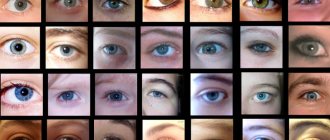The eyeball includes several membranes. The upper shell, the transparent cornea, is followed by the vascular layer, which is supplied with blood vessels and pigment cells. In the front part of the eye it is represented by the iris, which is responsible for the color of the eye.
The iris has special cells: chromatophores containing the pigment melanin, which shines through the cornea. The amount of melanin determines eye color: a large amount creates dark eyes (black, brown and light brown), and a smaller amount creates light eyes (green or blue). Red eye color is also found in humans and animals; its owners are called albinos. This is due to the fact that they completely lack melanin, so the color is determined by the blood in the vessels of the iris.
Cancer, jaundice, excess cholesterol. What health problems do the eyes reveal? Read more
Determining eye shade
There are four main eye colors. Mixed types are also known. The iris is as individual as a fingerprint. Physiognomy (a method of determining a person’s character by external facial features), in addition to shade, takes into account saturation and intensity. The artificial technique of reading faces describes the relationship between the concentration of the hue and the makings of a person. For example, the higher the brightness of the iris, the more a person corresponds to the characteristics of his type. Restrained notes minimize negative tendencies.
Photopigments of cone exteroceptors
The cones of the retina contain iodopsin and a type of iodopsin (cyanolab). All distinguish three types of iodopsin, which are tuned to wavelengths of 560 nm (red), 530 nm (green) and 420 nm (blue).
On the existence and identification of cyanolabe
Cyanolab is a type of iodopsin. In the retina of the eye, blue cones are located regularly in the peripheral zone, green and red cones are localized randomly over the entire surface of the retina. At the same time, the density of distribution of cones with green pigments is greater than that of red ones. The lowest density is observed in blue cones.
The following facts support the theory of trichromasia:
- The spectral sensitivity of the two cone pigments was determined using densitometry.
- Three pigments of the cone apparatus have been identified using microspectrometry.
- The genetic code responsible for the synthesis of red, blue and green cones has been identified.
- Scientists were able to isolate cones and measure their physiological response to irradiation with light of a specific wavelength.
The theory of trochromasia was previously unable to explain the presence of four primary colors (blue, yellow, red, green). It was also difficult to explain why dichromatic people were able to distinguish between white and yellow. Currently, a new retinal photoreceptor has been discovered, in which melanopsin plays the role of pigment. This discovery put everything in place and helped answer many questions.
Recent studies have also examined sections of avian retinas using a fluorescence microscope. In this case, four types of cones were identified (violet, green, red and blue). Due to opponent color vision, photoreceptors and neurons complement each other.
Dark brown eyes
Those with the darkest eyes are distinguished by leadership qualities and a strong energy field. They are always optimistic, very passionate, loving and determined. Scientists classify this type of people as “fiery.”
They do an excellent job running their own business thanks to their entrepreneurial spirit. Capable of achieving any goal. They never go with the flow. For them, the most difficult thing is the lack of development.
Black-eyed people with a hot temperament and high levels of adrenaline easily succumb to gambling hobbies. Due to their strong magnetism, they are often the center of attention. But there is also an extreme degree of personality type. Determination and drive can transform into an obsession. Such obsession is fraught with negative consequences.
Brown eyes - common characteristics
People with brown eyes have sensuality and a pronounced temperament. At the same time, their wit can cause acute temper. They are characterized by quick release. Able to easily forget grievances.
Representatives of this type quickly fall in love. For them, the most important thing is the initial stage of the relationship. But very soon they will get bored with the monotony. Especially if there is no response and constant encouragement. They give their warmth only in response to gratitude.
The weakest point is capriciousness. But this drawback is leveled out. After all, brown-eyed people are great at finding a common language with people and achieving what they want.
Features of light brown eyes
Several shades are known - bright hazel, light brown and tea eyes. They differ from representatives with dark pigmentation of the iris. They prefer to be in solitude, dream and build castles in the air.
They have increased sensitivity and vulnerability. They fly in the clouds, so even the smallest offense can cause serious injury. People with a predominant light shade of the iris are more modest, shy and indecisive. Passivity often interferes with their career growth, when decisive, active actions are required of them.
Positive aspects include reliability, hard work and diligence. They will never let you down in a difficult situation. But light brown eyes are not as simple as they seem. Softness, pliability and shyness hide the makings of a stubborn personality. Under strong pressure, they can do things their own way. If you instill self-confidence in them, they will achieve a lot.
There are four main types of eye color and several mixed ones. There are also albino people who are congenitally lacking the pigment melanin.
What determines eye color?
How do children inherit eye color? Is it possible to predict what it will be like in a child? Why are albinos pink? If both parents have brown eyes, can they have a blue-eyed baby? How is the color of the iris formed? These questions are relevant at all times. The answer to them is contained in the totality of internal and external characteristics of the organism, formed on the basis of the genotype, as well as acquired as a result of individual development. What does this mean and what determines the color of a person’s eyes?
This characteristic is determined by the pigmentation of the iris (iris), consisting of ectodermal (posterior) and mesodermal (anterior) layers. That is, the color of a person’s eyes depends on the nature of the distribution of fuscin (it promotes the production of visual pigment, absorbs light and prevents its scattering and reflection, resulting in improved clarity of visual perception of the image) in the pigment cells of the posterior layer and melanin (a natural dark substance) in pigment-containing and reflective cells cells (chromatophores) of the anterior layer. The color is also influenced by the condition of the vessels and fibers of the iris, the different amount and nature of the pigment, which, in turn, is determined by genetics. Eye color is determined by genes. But not all of them have been studied.
Melanin is a colored substance that affects not only eye color, but also hair and skin tones. Still, what does eye color depend on? The more melanin is contained in the mesodermal layer, the darker the iris, and the less it is distributed in the pigment cells of the anterior layer of the iris, the lighter it will be. There are brown and black melanin (or eumelanin), as well as yellow (or pheomelanin). Certain genes are responsible for the nature and quantity of this natural substance and its distribution. As a result, the color of the iris can be blue, blue, gray, green, amber, marsh, brown or black. The child will inherit the eye color of the parent with dominant traits (brown, light brown and green) and will not have the eye color of the parent with recessive traits (blue or grey).
In blue eyes, the posterior layer is colored blue due to the vessels formed by collagen fibers; the anterior layer is characterized by a minimal melanin content. Light blue differs from blue ones in the greater density of whitish fibers: the higher their density, the lighter the iris. The gray color of the eyes is explained by the even greater density of collagen. In the front layer of green there is a small amount of melanin, due to the blue color of the back layer, the iris is heterogeneous green and of different shades. What determines the color of amber eyes? The pigment lipofuscin ensures their uniform coloring. With a moderate content of melanin in the outer shell of the eyes, the eyes become swampy or hazel. Brown hair occurs when the chromatophores contain a lot of melanin. Blacks are characterized by a high content of this pigment, which completely absorbs light. In an albino, it is absent, and the iris appears pink or red due to the reflection of the color of the blood vessels.
Newborns have blue irises, but these may darken over the next few years. How does this explain and what determines the color of a child’s eyes? Melanin in the body at the time of birth is not produced in the fetus, since until this time protection from ultraviolet rays was not required, which is provided by a dark pigment. Its main purpose is to prevent radiation damage to body tissues. After childbirth, the production of melanin by specialized cells (melanocytes) begins. Therefore, the true color of a child’s eyes can be determined no earlier than three years, although changes sometimes occur up to 10-12 years. In adults, the color of the iris can also change under the influence of medications or due to deteriorating health. For example, a yellowish color appears due to the accumulation of lipofuscin.
Generally, brown eyes are considered dominant and blue eyes are considered recessive. But modern science has proven that everything is not so simple. The darker the color, the more dominant it is: brown over green, green over blue. But a child will not always be brown-eyed if mom and dad have brown irises. It may differ in children. It is usually caused by faulty development of pigment transport, local trauma either in the womb or shortly after birth, or a genetic disorder.
Blue eyes are a sign of emotionality
Owners of blue eyes are romantic, emotional and sensuality. They fall in love quickly. They can plunge headlong into the pool and devote themselves completely to relationships. But representatives of the type also hate strongly and take revenge in cold blood. Their enemies are not to be envied.
They give in to their emotions, so they say what they think. Only justice and truth matter to them. Capable of protecting their interests by all available means. Excessive subjectivity often prevents them from discerning the absolute truth. For this reason, others perceive blue-eyed people as arrogant and arrogant.
Their exposure to emotions makes them fearless and decisive. They have leadership qualities. But it is quite difficult for them not to follow the lead of their impulsiveness. It will take a lot of effort to learn to cope with your emotionality.
Romantics and dreamers with blue eyes
This type of people is vulnerable and sensitive. Romantic people often fantasize about a bright future. When faced with an imperfect reality, they can become depressed.
Despite the increased tendency to sentimentality, deep feelings are not inherent in them. Likes and affections often change. Pets are treated with all generosity and kindness. To others they show only cold condescension, and sometimes even cruelty.
Because of touchiness, even the most insignificant troubles are taken to heart. Mood can change every hour. Blue-eyed people cannot stand monotony. They constantly put forward increased demands not only on others, but also on themselves. Therefore, they often get blues if their expectations are not met.
Eyes the color of the sky can often be seen in creative individuals. Inexhaustible fantasy and imagination contributes to the development of imaginative thinking. Warm shades neutralize cold character traits. Those with soft notes have an easy-going character. They demonstrate selflessness and the ability to truly love.
A detailed relationship between eye color and temperament type can be found in the video:
Change in eye color - ring keratopigmentation in Germany
The color of a person’s eyes depends on the amount of coloring pigment (melanin) in one of the layers of the eyeball – the iris. Until recently, the only way to change the color of your eyes with minimal risk to your eyes was to wear colored contact lenses. However, constantly removing and putting on lenses caused some inconvenience, and some people who cannot tolerate lenses or have eye diseases, such as corneal pathology, could not use them at all.
The operation of ring keratopigmentation (in other words, the introduction of pigment into an artificially created ring-shaped canal inside the cornea) made it possible to change eye color once and for all. For the first time, such an operation for cosmetic purposes was performed at the end of 2013 by Strasbourg ophthalmologists on a woman who wished to change her eye color from brown to blue. They didn't have to bleach her iris to do this. Since the cornea is located outside the iris, it was enough to perform ring keratopigmentation with a blue pigment, and the brown iris became invisible - the eyes became blue. Over the past five years, their color has not changed, and since then, cosmetic keratopigmentation has become firmly established in the practice of the best ophthalmologists who master complex microsurgical technologies. Today, regardless of the natural color of the eyes, with the help of this unique operation you can become the owner of gray, hazel, green or turquoise eyes.
However, changing eye color, that is, the cosmetic effect, is not everything, and perhaps not the main advantages of microsurgical keratopigmentation. The fact is that the iris performs not only aesthetic, but also physiological functions - it regulates the intensity of the light flux entering the eye. Therefore, any defects in the iris result in serious problems for the patient. This is not only unsightly, but is also accompanied by photophobia, flashes that interfere with comfortable visual perception, and multiple contours of objects. And all together significantly reduces the quality of life and professional opportunities.
Defects of the iris and irregular shape of the pupil can be either congenital or acquired as a result of injuries, operations to remove tumors, the formation of epithelial cysts, atrophy, and poorly performed intraocular interventions. And all these patients require correction of the appearance and functions of the iris. Previously, in such cases, tinted contact lenses were used or it was necessary to implant an artificial iris, as well as intraocular (intraocular) tinted lenses. However, these methods have significant disadvantages - involvement of the central optical zone, reduced diaphragm abilities, mismatch between the profiles of the implant and the cornea, and the risk of suture protrusion. All these shortcomings were happily avoided by the method of microsurgical ring keratopigmentation. This operation allows you to replace the lost functions of the iris and thereby eliminate vision defects without requiring:
- interventions in the central optical zone;
- manipulations on intraocular structures;
- installation of intraocular implants;
- suturing.
In some cases, such an alternative to intraocular implants is of fundamental importance. For example, implantation of an artificial iris after removal of a natural one affected by a tumor is undesirable due to injury to the surgical area and the angle of the anterior chamber of the eye.
Briefly, the scheme of microsurgical ring keratopigmentation can be presented as follows:
- perform anesthesia;
- Ultrasound pachymetry is performed - measuring the thickness of the cornea;
- determine the central optical zone with a diameter of 3-4.5 mm. By the way, the operation can be successfully performed again if, after the first intervention, the patient is bothered by residual glimpses. In such cases, the diameter of the optical zone is slightly reduced;
- Using a microsurgical diamond scalpel, radial incisions are made to a depth of no more than ½ the thickness of the cornea from the border of the central optical zone to the limbus. The number of incisions depends on the clinical situation. If the operation is performed for cosmetic purposes, two incisions are sufficient; if there are complex iris defects, their number may increase;
- The cornea is separated through incisions, forming a circular tunnel in it. Its internal and external diameters are 4.5 mm and 9.5 mm, respectively. To form a tunnel, a femtosecond laser is used - a quantum generator of ultrashort pulses lasting 1x10 -10 seconds. Moreover, two tunnels can be formed at different depths of the cornea. If the operation is performed for the aesthetic purpose of changing eye color, one tunnel is sufficient. But if the iris has gross defects, the lower tunnel of the cornea is filled with dark pigment and screens them, and the upper tunnel is filled with the pigment of the eye color the patient wishes to have;
- Using a cannula with a diameter of 0.27-0.30 mm, the formed tunnel is filled with a special pigment of a pre-selected color. It is perfectly compatible with the structures of the eye, completely biologically inert, stable, has a gel consistency and is evenly distributed in the corneal stroma;
- in the postoperative period, to prevent complications, drugs that dilate the pupil, antimicrobial agents and dexamethasone are instilled into the eyes for 2 weeks.
Our site’s specialists will recommend you ophthalmologists who have the most successful experience in microsurgical keratopigmentation operations performed to change eye color, as well as for medical reasons. To do this, fill out an application or contact a specialist via chat.
Meaning of eye color - gray tint
Representatives of this type have a sharp mind, prudence, practicality, and realism. Thanks to their patience, friendliness, conscientiousness, and peacefulness, they are among the most pleasant interlocutors. We are always ready to help and give good advice.
Their inherent independence and self-sufficiency does not allow them to bury their heads in the sand. In any industry where they can apply their skills and knowledge, they rise to the occasion. It is quite difficult for them to tune into a sensual mood on their own. Therefore, gray-eyed people are in dire need of an inspiration or muse.
A dark shade of the iris is characteristic of individuals with a strong character. They are distinguished by stubbornness and courageous actions. Despite the imperious and strong-willed nature, this color indicates devotion and complaisance in relationships.
Rod photopigment rhodopsin
Rhodopsin belongs to the family of G-linked proteins, which is so named because of its transmembrane signal transduction mechanism. In this case, G-proteins located in the near-membrane space are involved in the process. When studying rhodopsin, the structure of this pigment was established. This discovery is very important for biology and medicine, because rhodopsin is the ancestor of the GPCR receptor family. In this regard, its structure is used in the study of all other receptors, and also determines functionality. Rhodopsin is named so because it has a bright red color (from Greek it literally translates as pink vision).
Gray-blue eye color and character are distinctive features
People who are dominated by several cold shades at once have a decisive, ambitious and purposeful character. All qualities depend on the intensity of the color and the superiority of one of the shades - blue or gray.
As a rule, all representatives are distinguished by honesty and calmness. It's quite difficult to piss them off. Thanks to their wit and ingenuity, they can easily use their excellent imagination and developed intuitive abilities.
Sensitivity and sentimentality are not inherent in them. It is often difficult for loved ones to communicate with them due to a lack of sensitivity and sincerity. They are especially valued for their loyalty and reliability.
Despite his fairness and independence, this type is in dire need of approval and all kinds of encouragement. Only then will people with gray-blue eyes not abandon you in trouble and help you with advice.
How to unravel the secret of our eyes
The eyes are the visual organ through which 90% of information about the world around us comes to us. In addition to this important sensory function, the eyes serve as our main decoration. What does eye color depend on? Two factors play a key role in the formation of color: the amount of melanin and the density (saturation, density) of fibers in the iris. Melanin is a pigment responsible for the coloring of tissues, that is, the larger its volume, the thicker, more intense and darker the tone; its color range ranges from yellow to brown-black. The pigment layer of the iris is always black, with the exception of albinism syndrome. Also, the presence of the yellow or light brown pigment lipofuscin plays a role in the formation of some colors. How exactly does this or that shade appear? Green eyes, so similar to emerald stones, are truly precious. In its pure form, without the inclusion of other tints, this color is extremely rare; only 2% of the planet's population can boast of it. Green is formed when there is a small percentage of melanin in the upper layer of the iris and lipofuscin is present. And, by the way, most often its owners are female. Blue, evoking thoughts of the depths of the sea and the expanses of heaven, is formed due to the low density of the fibers of the upper layer of the iris and the small volume of available melanin. The lower layer of the iris neutralizes the long-wave part of the spectrum (red-green), simply absorbing it, and reflects the short-wave part (blue-blue), which is how the eyes acquire a deep blue tint.
The higher the density of the fibers of the top layer, the lighter the shade of the eyes. This is how the blue color is formed. By the way, the largest number of owners of a blue-blue eye palette lives in Estonia - 99% of the population! If the density of the fibers is even higher, a gray-blue tone appears, and at maximum density, a gray color is formed. In addition, the presence of melanin or other substances can produce some yellowish or brown impurity, giving the main color additional inclusions in the shade. A very popular myth is that all babies are born with blue eyes. However, this is not entirely true. Children are born light-eyed, since there are no coloring pigments in their irises, and over time, as melanocytes - cells that produce melanin - accumulate, their eyes become darker. Amber eyes are characterized by a light brown color, occasionally with a yellowish-green or slightly reddish tint. And the presence of lipofuscin, a yellow-brown pigment, brings such eyes closer to a hazel or golden tone. Hazel eye color (sometimes also called marsh) is a combination color. In the upper layer of the iris, the amount of melanin is very moderate, which gives a blue-blue tone, and when it is combined with the yellow-brown lipofuscin present in the eye, that same hazel shade appears.
There are more brown-eyed people on the planet than others. This common color occurs when the top layer of the iris is filled with a very large number of melanocytes that absorb short-wavelength light (blue) and reflect the rest (red, green) - mixing, they give a more or less intense brown color. The black color only gives this impression, but in reality it is dark brown. Due to the very high concentration of melanin, the incident light is absorbed almost completely, and it appears that the eyes are jet black. Sometimes you can encounter people with different colored eyes, which is called heterochromia. It occurs when the eyes (either right and left - complete heterochromia, or one, but in different parts of the iris - partial heterochromia) contain different amounts of melanin pigment. In the first case, the eyes have completely different colors, most often blue and brown; in the second, the iris is painted in several colors, for example, there may be a gray spot on a brown background.
There are also eyes with a reddish and pinkish tint - the owners of such extraordinary eyes are albinos. This effect occurs due to the absence of coloring pigment in the iris, so the color of the eyes is determined by the color of the blood in the retinal vessels. Sometimes burgundy red, merging with blue, gives a slightly purple tint to the eyes, but this is usually only noticeable from a certain angle and lighting. It turns out that there is no mystery in the formation of eye color, but at the same time you will never meet a person with exactly the same eye shade as yours!
Character by eye color – gray-green shade
By nature, pragmatic and hardworking individuals are endowed with eyes of this color. They are characterized by justice, constancy and patience. They perfectly control their emotions and remain impartial in any situation. They win disputes and difficult situations thanks to a cool mind and informed decisions.
Unlike other types of physiognomy, despite their practicality, sobriety and realism, they are able to remain soft and delicate. They know how to show empathy, listen and hear the interlocutor, and also provide the right support. In addition, they received acute intuition, mental flexibility and strong willpower.
Green-eyed people are a rare type
It is extremely rare in its pure form. It is distinguished by sensuality and tenderness. In relationships they give themselves completely. It is very difficult to earn their favor. They are self-critical, but at the same time demand perfection from others. The feeling of falling in love is taken seriously. That's why relationships last a long time. They always remain faithful to their soulmate.
The positive aspects include tenderness, kindness and responsiveness. People around them don’t like their integrity and firmness. They have the ability to understand people perfectly. They actively use their “psychic” qualities in their careers and personal lives.
Despite their inaccessibility, pride and independence, green-eyed people are preferred as interlocutors. They give tenderness and affection, but to earn their favor, you need to make a lot of effort. At any moment they are able to show the negative sides of their character.
Physiognomy, in addition to the shade of the iris, also studies the shape and location of the eyeball.
Yellow eye color
Extraordinary personalities are endowed with the so-called snake or tiger eyes. They have artistic talent, charm and charisma. They know how to “read” other people’s thoughts. They are flexible, fearless, resourceful and resourceful. Despite its cunning nature, a yellow iris indicates generosity, kindness and devotion. With such friends and spouses, you don't have to worry about anything.
If they encounter people with unclean thoughts, they may show hostility and deceit. It is true what they say that yellow eyes see right through the soul.
Eyes truly reflect a person's inner world. There are unique people who have irises of different shades (heterochromia). This feature is caused by different concentrations of melanin. There are complete heterochromia (eyes of different colors) and partial (one eye has several shades of the iris). The visual organ also tends to change color depending on lighting, makeup, clothing and emotional state. With age, as a rule, the iris brightens and loses its original brightness.
Scientists capture light coming from human eyes for the first time
Rays of light from the eyes are not at all mystical.
The phenomenon, which was sometimes reported by patients undergoing radiation therapy, was considered mystical. Doctors mentioned it in the literature, but did not particularly believe it - they say, people simply imagined it. Eyewitnesses insisted that they clearly saw a blue light before their eyes - very bright rays. Although they were in complete darkness.
Diagram of the research facility.
American scientists from Dartmouth College (Thayer School of Engineering, Dartmouth College) and the Norris Cotton Cancer Center at Dartmouth-Hitchcock Medical Center undertook to deal with the mysterious visions. Led by Irwin Tendler and Lesley Jarvis, they did something very simple: they pointed a sensitive camera (CDose) at the eyes of patients undergoing radiation therapy - that is, radiation for medical purposes.
It turned out: the light that “blinded” the eyes came from... the eyes themselves. It was they who emitted the rays. In the report, which the scientists published in the International Journal of Radiation Oncology, Biology, & Physics, they wrote: "the light was sufficient to produce a visual sensation." Thus, for the first time - in real time, as the authors emphasized, it was possible to verify that the light appearing in the darkness of the radiation chamber is by no means mystical, but some kind of real phenomenon. It remained to explain its nature.
The eyes emit rays of varying intensities. Bottom right is a glowing eye in a tomograph image.
According to the portal “EurekAlert!”, after analyzing the spectrum of rays emanating from the eyes, the researchers came to the conclusion that they were “turned on” by the so-called Cherenkov effect, which occurs in the eyes.
The Cherenkov effect or Cherenkov radiation, a phenomenon discovered by Soviet scientists back in the 30s of the last century, appears in transparent liquid media under the influence of flying charged particles - usually electrons, the speed of which is higher than the speed of light in these media. The color of the radiation is blue. In a similar way, for example, nuclear reactors surrounded by water glow.
The particles that cause Cherenkov radiation in the eyes are also electrons. They are knocked out of the atoms by gamma radiation, which is irradiated to the patient. The role of a transparent liquid medium is played by the vitreous body of the eyeball.
The ability of the eyes to glow is interesting in itself. However, Tendler, Jarvis and colleagues also see practical meaning in it. It is believed that the discovered phenomenon will make radiation therapy more effective. Since the rays from the eyes are a kind of visible signals, indicating that the radiation has reached its target and is likely to work.
BY THE WAY
We are all bright individuals
It seems that the results obtained by the Americans now have added meaning to the experiments that their Japanese colleagues from Kyoto University and the Tohoku Institute of Technology conducted 10 years ago. They recorded the light emitted by the bodies of people - unirradiated volunteers sitting naked to the waist in a completely dark room. Every three hours - from 10 am to 10 pm - they were filmed for 20 minutes by a camera that reacts even to very weak radiation from biological objects.
Schematic of a Japanese research facility.
Processing of the captured images showed that the whole body glows. Emits in the visible range. The light is very ghostly - a thousand times weaker than what the human eye can detect. But he is. The Japanese reported this in the journal PLoS ONE. Moreover, they discovered that the intensity of the rays emitted by the body varies depending on the time of day. According to Hitoshi Okamura from Kyoto University, people are brightest at 4 pm. Then the intensity drops.
People are at their brightest at 4 pm.
The most radiant parts of the body are the face, eyes and the area around the thyroid gland. Each square centimeter emits approximately three thousand photons.
Photos of the glow are very similar to the pictures that are obtained if you photograph a person in the invisible infrared (thermal) range. But the researchers emphasize: there is nothing in common in a particular case. They painted areas of different luminescence intensities in the visible range with different colors - from blue to red. Blue ones correspond to the smaller one, red ones correspond to the larger one. And they show the number of photons emitted from a square centimeter of the body. And not how heated these places are.
The Japanese at one time sinned on the “chemistry” of the body - on oxidative reactions in which so-called free radicals are involved. But even then they doubted that this was the only explanation for the nature of the glow of the human body. So maybe the Cherenkov effect intervenes here too? And radiation - the one that creates a natural background?
Areas of different colors correspond to the emission of light of different intensities.
THE SECRET OF EXTRASENSE REVEALED?
Photons of our thoughts
Masaki Kobayashi from the Institute of Technology, one of the researchers of the glow of the human body, believes that it is still connected with the work of the body and reflects the state of its various systems. And this allows us to assume that some people are still able to perceive it. Even though the intensity of the glow is very weak. It is possible that psychics and other “X-ray people” make their diagnoses this way.
Let's be even bolder. Since the head, in which, as is known, thoughts are born, glows most of all, then why not assume that they also have something to do with the emission of photons? And to telepathy - the ability of some people to capture photons of thoughts? After all, other photons, as recently discovered, behave quite remarkably.
The results of a study by Andreas Ringwald, who works at the German synchrotron (German Electron Synchrotron - DESY- in Hamburg), published in the Journal of High Energy Physics, indicate that under certain conditions, photons are able to penetrate through any obstacles. For example, those launched from one side of the Earth may end up on the other side. And this is by no means fantasy. Physicists call such particles “hidden” or “hidden photons.” And they even plan to use them for long-distance communication - to transmit secret messages.
Who knows, what if telepaths by nature already have the gift of feeling something “hidden”? Perhaps some “ordinary” people also sometimes acquire a similar ability. And they miraculously find out what is happening to loved ones who are thousands of kilometers away from them.
It seems, by the way, that a person is capable of emitting a fairly strong stream of photons. For example, the famous Soviet psychic Ninel Kulagina exposed photographic film placed over her eyes in a completely dark room. What, if not the rays discovered by the Japanese and Americans?










